Excretory Products and their Elimination
EXCRETORY WASTE
Metabolism Excess ingestion
|_________________________________|
↓
Results in accumulation of
Nitrogenous wastes– NH3, urea, uric acid
Offer contents- CO2, H2O, ions (Na+, K+, CL-, PO4-3, SO4-2) Removed.
↓
Partially/Completely.
NITROGENOUS WASTES
- Nature of nitrogenous waste formed and their excretion vary among animals depending on the habitat/availability of water.
Major Nature & Toxicity and Typical
nitrogenous Examples water
waste required
Ammonia Ammonotelic Maximum Diffusion
Aquatic insects Through Gills
Many bony fishes surface or
Aquatic body surface
amphibian as ammonium
ions
Urea Ureotelic Lesser Kidneys filter
Marine fishes urea from
Many terrestrial blood
amphibians
Mammals
Uric acid Uricotelic Least Pellet/Paste
Land snails
Insects
Reptiles
Birds
Notes:- - Ammonia converts into urea in liver.
- Elimination of urea, uric acid is meant for conservation of water i.e. a type terrestrial adaption.
- Kidneys do not play a significant role in removal of ammonia.
- Some amount of urea may be retained in the kidney matrix of some animals to maintain desired osmolarity.
EXCRETORY STRUCTURES
- Most invertebrates- Simple tubular forms
- Vertebrates- Complex tubular organs called kidneys.
Structure Examples
Protonephridia/ Platyhelminthes (Planaria)
Flame cell Rotifers
Nephridia Some annelida
Cephalochordates (Amphioxus)
Nephridia Annelids (Earthworms)
Malpighian Insects (Cockroaches)
Antennal/Green glands Crustaceans (Prawn)
Notes;-
- Protonephridia are primary concerned with osmoregulation
- Functions of excretory structures :
Eliminate nitrogenous wastes
Maintain ionic and acid-base balance of body fluids, i.e. osmoregulation.
HUMAN EXCRETORY PRODUCTS AND THEIR ELIMINATION SYSTEM
- 1 pair, bean shaped, reddish, brown
- Length 10-12 cm, Width 5-7 cm, Thickness 2-3 cm.
- Weight 120-170 gram.
- Between T12- L3 vertebra, close to dorsal inner wall of abdominal cavity
- 1 pair
- Have stretch receptors
- Store urine till voluntary signals from CNS carries out its release.
- Guarded by sphincters
- Meant for release of urine.
MICTURITION
- Process of release of urine
- Mechanism- Micturition reflex
↓
Urinary bladder ( Store urine)
↓ Activates
Stretch receptors- signals ↔ CNS (voluntary signals)
↓ Send motor messages
Urinary bladder
Smooth muscles contract
Urethral sphincters relax
↓ Release
Urine.
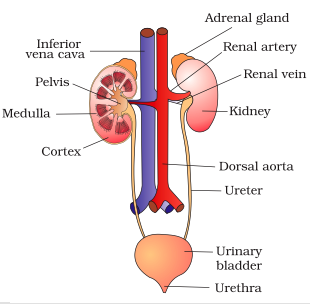
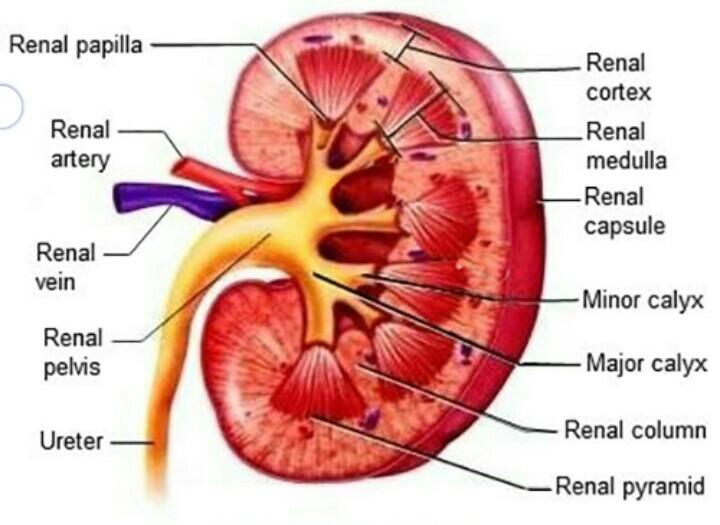
NEPHRON
- Functional unit of kidney
- Nearly 1 million/kidney
- Each nephron has two parts (i) Glomerulus (ii) Renal tubule.
Types of Nephron
Parameters Cortical Juxtamedullary
Number More Less
Loop of Henle Too short Very long
Extension into medulla Very little Deep
Vasa recta Absent/reduced Present
- Juxtaglomerular apparatus (JGA)
Sensitive region formed by cellular modifications in distal convoluted
tubule and afferent arteriole at the location of their contract. - Nephrons are dipped in interstitial fluid having specific osmolarity- Cortex- 300 mOsm/L- Medulla- upto 1200 mOsm/L (Gradient).
- Glomerulus is a tuft of capiliaries formed by afferent arteriole- a fine branch of renal artery.
- Malpighian corpuscle, PCT, DCT- Located in cortex.
- Loop of Henle- Dips into medulla
- Many DCTs open into straight tube called collecting duct, many of which converge into renal pelvis through medullary pyramids in the calyces.
- Efferent arteriols emerging from glomerulus forms peritubular capiliaries around renal tubule.
- Vasa recta:-
Branch of peritubular capillaries
Parallel to loop of Henle
‘U’ shaped
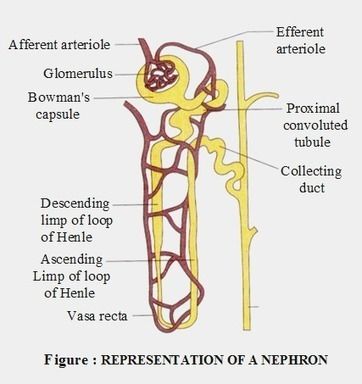
URINE FORMATION
Main processes:-
- Glomerular filtration:- 180 L filtrate /day
Tubular reabsorption:- nearly 99% of filtrate get reabsorbed by renal tubules
↓By
|________________________|
↓
Active process Passive process
Glucose,Na+ amino acid Nitrogenous waste, H2 O
3. Tubular secretion:-
H+, K+ ammonia secreted into filtrate
Maintains ionic and acid base balance.
Non- selective process →Glomerular Filtration/Ultra filtration
1/5 of cardiac output or 1100-1200 ml blood/min is filtered by kidneys
↓
Renal Artery
↓
Arterioles
↓
(i) Endothelium of glomerular blood vessels |
↓ |
(ii) Basement membrane |→Filtration
↓ | membrane
(iii) Epithelium of Bowman’s capsule |
↓
Glomerular filtrate – Bowman’s capsule have (Plasma except proteins) podocytes arranged in intricate
manner so as to leave some
spaces called slit pores
/filtration slits
Parameter Descending limb Ascending limb
Permeable Water salt
Impermeable Salt water
Filtrate Concentrated Diluted
↓ ↓
Concentrating Diluting (Minimum reabsorption)
limb limb
Note:-
PCT
- Lined by simple cuboidal brush border epithelium.
- Nearly all essential nutrients, 70-80% electrolytes and water are reabsorbed.
- Major site of re absorption & selective secretion
- Filtration is due to pressure in the glomerular capillaries.
- Glomerular filtration rate (GFR) = Filtration/min 125 ml/min
- kidney has an ability to regulate GFR.
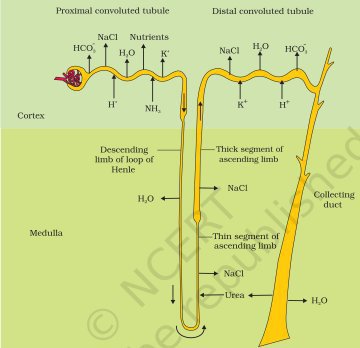
COUNTER CURRENT MECHANISM TO CONCENTRATE FILTRATE
- Flow of filtrate in different limbs of following structures are in opposite direction (counter current).
- Loop of Henle (HL)
- Vasa recta (VR)
- HL and VR
- Proximity of HL and VR and counter current in them increase osmolarity towards inner medullary interstitium (300 mOsm/L in cortex to 1200 mOsm/L in inner medulla).
- Interstitium gradient is caused by NaCl and urea.
- NaCl transported by ascending limb of HL exchanged with descending limb of vasarecta and is returned to medullary interstitium by ascending lib of VR.
- Urea which enters in thin part of ascending limb of HL is transported back to interstitium by collecting tubule.
- This mechanism maintain interstitium concentration gradient that helps in easy passage of water from collecting tubule thereby concentrating filtrate (urine)
Note:-
- HL primary helps to maintain osmolarity gradient in kidney interstitium .
- Mammals have ability to produce concentrated urine.
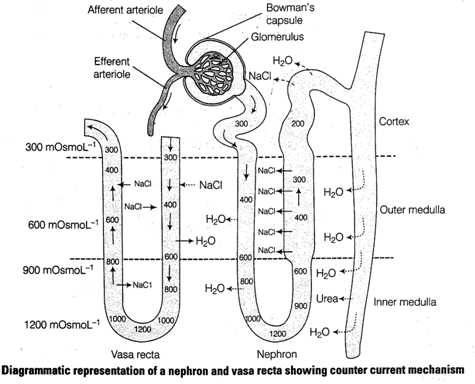
REGULATION OF KIDNEY FUNCTION/GLOMERULAR FILTRATION RATE
Hypothalamus JGA
Low blood volume/ Low GFR/Glomerular
body fluid volume/ blood flow/ Glomerular
Ionic concentration blood pressure
↓ Activate ↓ Activate
Osmorsceptors of JG cell to
hypothalamus to release release renin-Angiotensinogen-Angiotensin I
ADH/Vasopressin from ↓
neurohypophysis Angiotensin II
↓Works works ↓
Constrict blood vessels Constrict blood vessel
Increase re absorption of
water from DCT Activate adrenal cortex
(Prevent diuresis) to release aldosterone,
↓ Result that causes reabsorption of
Blood volume increase Na+ and water
Blood pressure increase Result ↓
GFR increase
Increase in blood volume Blood pressure increase GFR increase
↓ Switch off (Renin-Angiotension mechanism)
Osmoreceptors
↓Suppress
ADH/Vasopressin
Heart
Increase blood flow to atria of heart
↓
Release of ANF (Atrial Natruretic Factor)
↓Work
Vasodilation
↓ Result
Blood pressure decrease
GFR decrease
Note:– ANF mechanism acts as a check on Renin- Angiotension mechanism.
CHARACTERISTICS AND COMPOSITION OF URINE
- Colour- Light yellow
- pH= 6
- Odour-Characteristic
- Human kidneys can produce urine nearly 4 times concentrated than initial filtrate.
- Urea- 25-30 gm/day
- Various conditions can affect characteristics of urine.
Abnormal constituents Condition Indicate
of urine
Glucose Glycosuria Diabetes mellitus
Ketone bodies Ketonuria Diabetes mellitus
Note:- Analysis of urine helps in clinical diagnosis of many metabolic disorders as well as malfunctioning of the kidneys
DISORDERS OF EXCRETORY SYSTEM
Disorders Symptoms or Treatment
Renal calculi – Stone or insoluble mass of crystallised salts (e.g. oxalates)
Glomerulonephritis– Inflammation of glomeruli of kidney
Renal/kidney failure– Malfunctioning of kidneys leads to accumulation of
urea in blood(Uremia), highly harmful, may lead to kidney failure
Treatment:-
Haemodialysis:- Process to remove urea from blood
Method is a boon for thousands of patients all over the world.
Blood drained from artery→ Mix with→ Heparin (Anticoagulant)→Pump through→ Dialysing unit (Artificial kidney
porous cellophane
tubes surrounded
by dialysing fluid)→ – Filtration based on
concentration gradient- Nitrogenous wastes
freely move out
Mix with clear blood↓
Anti heparin
Pumped back to body through↓
Vein
(ii) Kidney transplantation
Ultimate method in correction of acute renal failure
- Functional kidney is taken from donor.
- To minimize rejection, close relative are preferred as donor
- Modern clinical problems have increased success rate of such complicated techniques.
Note:– Composition of dialysing fluid is same as plasma except the nitrogenous wastes.
ROLE OF OTHER ORGANS IN EXCRETION
Accessory Remove Basic work
structure
Lungs CO2, water Remove large amount of CO2 approximately 200 ml/min
Remove significant quantity of water
Liver
(Largest gland) Bilirubin, vitamins Most of these substances pass out biliverdin, drugs alongwith digestive wastes
biliverdin, drugs,
cholesterol, degraded
steroid hormones
Skin Sweat contains Primary function of sweat is to facilitate
Sweat glands NaCl cooling effect on body surface.
Urea
Lactic acid
Sebaceous Sebum contains Sebum provides a protective clly glands Sterole converting for
Hydrocarbons
Waxes
salivary Small amount of nitrogenous wastes
glands are eliminated through saliva.